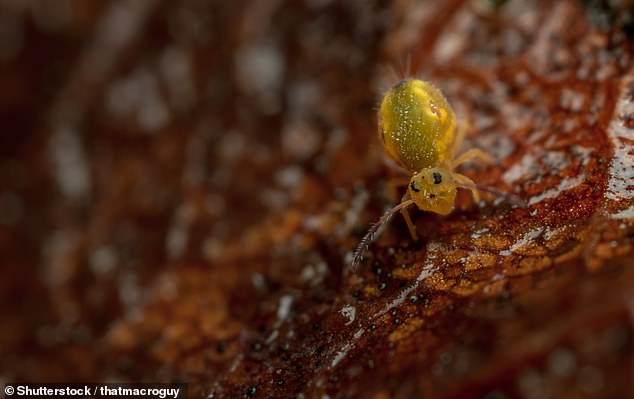Move over, Sonic! A tiny backyard insect can do the fastest backflips on Earth – he spins 368 times per SECOND
When it comes to jumping creatures, you probably immediately think of Sonic the Hedgehog.
But the video game character pales in comparison to a backyard insect who claims to be the fastest flipping creature on Earth.
The globular springtail (Dicyrtomina minuta) can complete 368 rotations per second, according to new research led by North Carolina State University.
Incredible footage shows the little insect showing off its jumping skills, which would put the best acrobats in the world to the test!
“This is the closest you can get to a Sonic the Hedgehog jump in real life,” said Dr Adrian Smith, who led the research.
The bulbous springtail (Dicyrtomina minuta) can complete 368 rotations per second, according to new research led by North Carolina State University
Bulbous springtails are tiny insects only 0.2 inches (6 mm) long and are found in gardens in the UK and US.
They can’t fly, bite or sting, but they can jump.
In their new study, the researchers wanted to understand exactly how the insects do this.
“When globular springtails jump, they don’t just jump up and down, they also spin through the air,” Dr. Smith said.
‘So of course I wanted to see how they do that.’
The researchers ‘recruited’ the globular springtails for the study from Dr. Smith’s own garden, but it proved difficult to film the speedy creatures.
“Globular springtails jump so fast that you can’t actually see it,” Dr. Smith said.
‘If you try to film the jump with a normal camera, the springtail appears in one frame and then disappears again.

Bulbous springtails are small insects only 6mm long that can be found in gardens in the UK and the US. Although they cannot fly, bite or sting, they can jump

When it comes to spider-jumping creatures, you might think of Sonic the Hedgehog. But the video game character pales in comparison to a backyard insect that lays claim to the title of fastest-flipping creature on Earth.
“If you look closely at the photo, you can see faint curling vapor trails left behind where the image flipped.”
To solve this problem, the researchers used cameras that can shoot 40,000 frames per second.
By lightly touching the insects with a brush or shining light on them, the team was able to analyze how the insects took off, how fast and how far they went, and how they landed.
The footage revealed that globular springtails do not use their legs to jump, but instead rely on an appendage called a furca.
This folds up under their abdomen and has a small, forked structure at the end.
When the insect wants to jump, the furca folds down and pushes the forked end against the ground, propelling the insect into the air.
“A spherical springtail takes only a thousandth of a second to do a backflip from the ground and can then reach a maximum rotational speed of 368 rotations per second,” Dr. Smith said.
‘They accelerate their bodies to jump, at about the same speed as a flea, but then they also turn.

Globular springtails do not use their legs to jump, but instead rely on an appendage called a furca. This folds up under their abdomen, and has a small, forked structure at the end
‘No other animal on Earth can do a backflip faster than a bulbous springtail.’
The spherical springtails not only spin quickly, but also very high.
The footage showed that the insects can launch themselves more than 60 millimeters into the air – more than 60 times their own height.
“They may lean and move sideways a little bit when jumping, but when jumping from a flat surface they mainly go up and backward, never forward,” said study co-author Jacob Harrison.
“Their inability to jump forward was a sign to us that jumping is primarily a way to escape danger, rather than a form of locomotion.”
When it came to landing, the researchers identified two equally common styles: uncontrolled and anchored.
When landing with anchor, the insects expelled a sticky, forked tube from their bodies, which could grab onto a surface and thus stop their freedom of movement.
Meanwhile, during uncontrolled landings, the insects would simply bounce and tumble until they came to a stop.
“This is the first time anyone has fully described the jumping performance of the globular springtail, and what they do is almost impossibly spectacular,” said Dr. Smith.
“This is a great example of how we can find incredible, and largely undescribed, organisms living all around us.”
